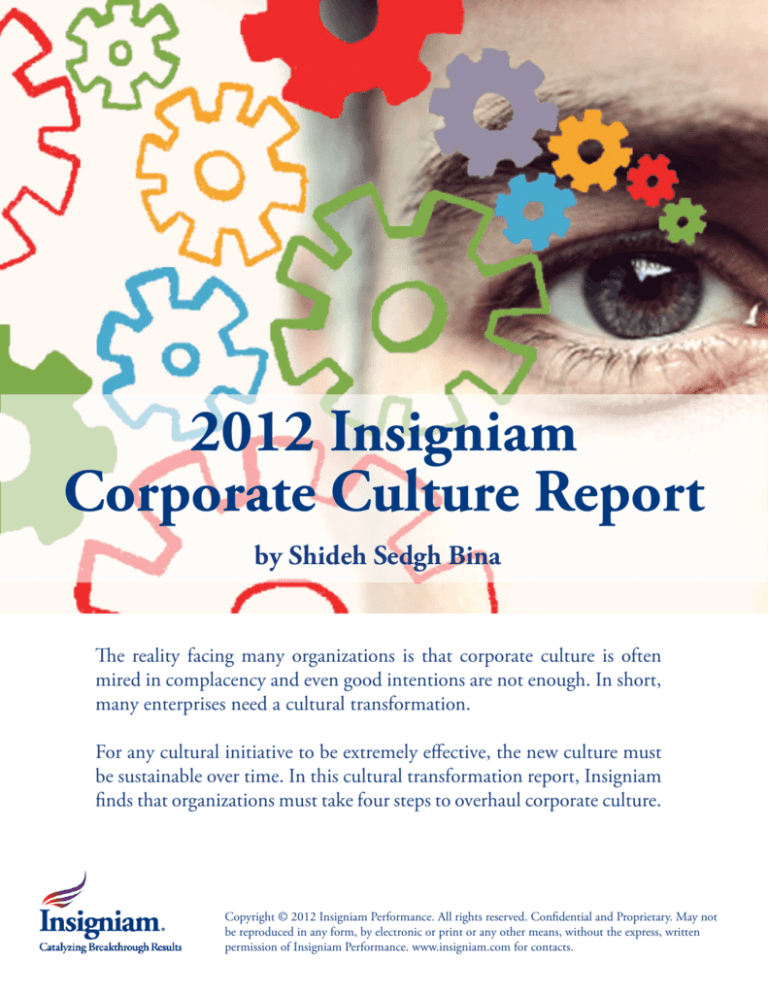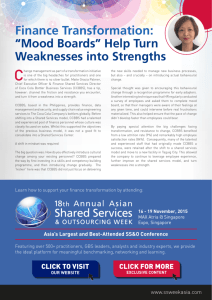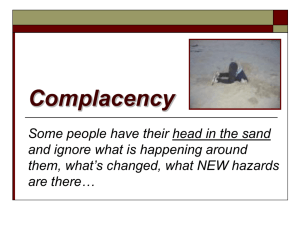
2012 Insigniam
Corporate Culture Report
by Shideh Sedgh Bina
The reality facing many organizations is that corporate culture is often
mired in complacency and even good intentions are not enough. In short,
many enterprises need a cultural transformation.
For any cultural initiative to be extremely effective, the new culture must
be sustainable over time. In this cultural transformation report, Insigniam
finds that organizations must take four steps to overhaul corporate culture.
Copyright © 2012 Insigniam Performance. All rights reserved. Confidential and Proprietary. May not
be reproduced in any form, by electronic or print or any other means, without the express, written
permission of Insigniam Performance. www.insigniam.com for contacts.
2012 Insigniam Corporate Culture Report
Corporate culture in the news
News-making corporate ethics investigations and organizational scandals are putting corporate culture under
new scrutiny. As investigators untangle breakdowns at some of the most venerable institutions around the
world, it’s clear that no organization is immune.
Consider the patterns emerging from investigations of BP, Penn State, and Goldman Sachs; good intentions
and rigid compliance measures cannot alone reduce risk.
Other dynamics include a fiercely competitive global economy, changing technologies, constant change, and
the new consumer who no longer demonstrates brand loyalty as in decades past. In short, business-as-usual is
no longer a safe formula for survival.
The reality facing many organizations is that corporate culture is often mired in complacency and even good
intentions are not enough. In short, many enterprises need a cultural transformation.
The complacency crisis
When we originally polled international executives about the state of corporate culture, the statistics made it
clear that even good intentions had harmful effects. More than 42% of leaders were frustrated with their
employees, blaming complacency.
Successful companies that sustain great results time and time again are not the product of happenstance.
Culture is what propels these organizations to achieve remarkable feats regularly. Although many organizations
have undertaken culture initiatives in an attempt to curb complacency, the old adage, “the more things change,
the more they stay the same,” is never more true than in a culture change initiative. 47% of executives blame
culture as the biggest roadblock to innovation.
Unfortunately, the list of companies that have undertaken culture initiatives that have at best merely resulted
in new vision and values placards significantly outnumber the list of enterprises that have truly constituted new
and robust cultures.
However, much work can be done to intentionally design and establish a work culture that brings out the best
in employees in pursuit of the enterprise’s purposes and ambitions.
For any cultural initiative to be extremely effective, the new culture must be sustainable over time. In this
cultural transformation report, Insigniam finds that organizations must take these four steps to overhaul
corporate culture.
For more information, or to speak with one of our partners about this report, please
contact Alexes Fath at afath@insigniam.com or +1 610-667-7822, Daniel Ducharme at
dducharme@insigniam.com or +33 1 49 27 01 79, or Felicity McRobb at
fmcrobb@insigniam.com or +852 2526 8801. ©2012 Insigniam Performance
1
2012 Insigniam Corporate Culture Report
1. Align strategy and culture with individual transformation for elevated performance.
Results from investigations into the BP Deepwater Horizon accident correlate that good intentions are not
enough to sustain or improve performance. Indeed, as the safety panel discovered, a narrow focus on the details
of personal safety and corporate policy actually interfered with the prevention of major hazards.
As the Huffington Post recently reported, “The board said there is a difference between worker safety and
making sure the entire rig and well are safe, and the latter area is where BP and Transocean were “inadequate.’”
The same pattern of complacency toward serious risk was also noted years earlier at another fatal fire in 2005.
Despite the panel’s safety recommendations, the protective measures were not implemented at Deepwater
Horizon, resulting in 11 deaths and substantial environmental damage.
As these examples show, a company’s culture can enable or hinder the successful execution of its strategy. At the
same time, the requirements and demands of the strategy may or may not be compatible with the culture and,
throughout it all, success depends on the thinking, behavior, and actions of individuals. It is critical that the
culture enables the strategy and that the strategy reinforces the culture.
Moreover, each individual needs to understand the direct correlation between his or her actions, the culture,
and succeeding at the strategy. When alignment of strategy, culture, and individual responsibility is achieved,
there is inevitably a tremendous increase of elevated performance.
2. Recognize that organizations are complex, ever-changing, adapting systems.
One does not have to be a leader for long to reach the disheartening conclusion that a drive for sustainable
change can be rather elusive.
The extensive Freeh Report on the Penn State child abuse investigation reveals a rallying demand for cultural
transformation, disclosing that “there is an over-emphasis on ‘The Penn State Way’ as an approach to decisionmaking, a resistance to seeking outside perspectives, and an excessive focus on athletics, that can, if not recognized, negatively impact the University’s reputation as a progressive institution.”
That very approach, the report says, resulted in the four most powerful leaders at the university failing to protect
children and compromising the institution’s integrity, ultimately affecting lives, careers, reputations, and even
the very athletics program that it was trying to protect.
Those core issues in a complacent culture aren’t so different in many organizations. Unfortunately, many leaders
are encountering a top-down decision-making process, resistance to change, and an excessive focus on a narrow
product, service, or area.
For more information, or to speak with one of our partners about this report, please
contact Alexes Fath at afath@insigniam.com or +1 610-667-7822, Daniel Ducharme at
dducharme@insigniam.com or +33 1 49 27 01 79, or Felicity McRobb at
fmcrobb@insigniam.com or +852 2526 8801. ©2012 Insigniam Performance
2
2012 Insigniam Corporate Culture Report
Perhaps the biggest contributor to this basic problem is a view of the enterprise as a fixed and linearly organized
entity where action A causes reaction B in a predictable and orderly fashion. An example of this might be
communicating new values, vision, etc. in several different formats, thinking that repeating the same message
enough will result in the audience embracing and internalizing the new cultural expectations.
In fact, organizations are not linear and captured in one place. Organizational culture emerges from the collective behavior of all the individuals in the company, each interacting and reacting independently and locally in
response to local conditions and partial information.
For instance, during a meeting about a new company mission or updated values, the audience may see the same
presentation, but each individual interprets pieces of the message that fit his or her own individual frame of
reference, colored by past experience, current mood, stress level, most recent skirmish with the other functional
area, the boss’s latest management blunder, and pending deadlines. The message is partially heard, mostly
altered, and easily lost.
Cultural transformations that are most effective and potent call upon the science of complex adaptive systems as
an organizing framework, are unique and custom-designed for each company, and address key elements such as
the past and present conditions, the pull of the future, and inspirational leadership.
3. Anchor culture in business results.
Culture has a direct, measurable impact on business results. When employees are disengaged, business results
falter. What if you could harness the very best behaviors, actions, and commitments as one collective ambition?
Results would skyrocket.
Business enterprises are not rhetorical exercises; they are very pragmatic and realistic endeavors to add value to
the economic interests of its owners, customers, and employees.
However, doing things the same way again and again will only be effective until a competitor does it better. As
CNN Money reports, Microsoft’s narrow focus on profitable products is also putting it behind other competitors. David Goldman writes, “That narrow obsession is what has sustained Microsoft’s remarkable financial
success for more than three decades. It’s also the obstacle that made it a runner-up to Apple, Google, and Facebook, in crucial consumer categories like smartphones, tablets, music, media, search, and social networking.”
We suggest that any initiative in a business enterprise must exist in service of the elevated performance of the
company. Moreover, if you consider that culture is demonstrated by the behaviors of the individuals in the
enterprise, it stands to follow that a truly effective culture transformation will evidence itself in significantly
enhanced business performance.
For more information, or to speak with one of our partners about this report, please
contact Alexes Fath at afath@insigniam.com or +1 610-667-7822, Daniel Ducharme at
dducharme@insigniam.com or +33 1 49 27 01 79, or Felicity McRobb at
fmcrobb@insigniam.com or +852 2526 8801. ©2012 Insigniam Performance
3
2012 Insigniam Corporate Culture Report
As a business experiment, Goldman reports that Microsoft is unleashing some of its brightest and boldest minds
to invent anything they’d like—regardless if it fits in the business strategy or not. Early reports are indicating
that this unusual research division is creating amazing innovations. These innovations still haven’t left the lab; so
it’s too early to tell if the culture will support this move to change business results, but consider how culture is
already impacting their collective views:
“People who work here are here because they want to see their stuff end up in customers’ hands,” says Microsoft’s Kevin Schofield in a CNN Money story. “We’re always asking ourselves: How do we push boundaries
faster? And how do we bring this to market?”
4. Generate breakthrough performance while generating change.
Is it possible to experience remarkable results in the middle a culture shift? Insigniam management consulting
experts have experienced this phenomenon many times in the course of decades of helping clients design and
generate a new corporate culture. It may seem counterintuitive at first, but once leaders and employees are
unshackled from the old way of doing things, workers are energized with a passion and purpose for achieving
the unthinkable.
Practical experience shows that the cultures in enterprises that produce business-as-usual results are quite
distinct from cultures in enterprises that produce consistent levels of breakthrough. What steers one toward
greatness while the other struggles with flat results?
Cultural transformation is best carried out through a set of activities and initiatives that can include key
business projects, organization practices, leadership development, communication campaigns, and a comprehensive cascade plan.
Imagine the possibilities of a quick-hit initiative that demonstrates a new performance dynamic in 30 to 60
days. Our clients have done it – and enjoyed the results.
The need for cultural transformations isn’t making the news because it is a new business problem—it is an old
problem that requires a different approach. Getting beyond the status quo of complacency and addressing the
enterprise fallout created by a misaligned, poorly focused culture is more than just recognizing the need for
change. It is the application of strategy that will not only create a seismic shift in culture, but push through
boundaries for quick results and set the stage for lasting success.
For more information, or to speak with one of our partners about this report, please
contact Alexes Fath at afath@insigniam.com or +1 610-667-7822, Daniel Ducharme at
dducharme@insigniam.com or +33 1 49 27 01 79, or Felicity McRobb at
fmcrobb@insigniam.com or +852 2526 8801. ©2012 Insigniam Performance
4
2012 Insigniam Corporate Culture Report
About Insigniam
Insigniam is an international management consulting firm serving large-cap firms in multiple industry segments
including pharmaceutical, healthcare, consumer goods, transportation, banking, and finance. Insigniam clients
have documented in aggregate more than 50x ROI in savings and business results through enterprise transformation, Breakthrough Projects, innovation, and short- and long-term change initiatives.
About the Author
When C-level leaders are ready to become extraordinary, they seek out Shideh Sedgh Bina for help. Known as
a powerful and potent leader, she brings more than 25 years of experience in consulting, business development,
and management to Insigniam.
Shideh is an expert in change management and Enterprise Wide Transformations. She is uniquely skilled at
developing leaders, improving business operations, and helping her clients create Breakthrough Results on their
own. She is a highly regarded and sought-after speaker on Breakthrough Performance as well as culture
transformations. Shideh has been a keynote speaker at numerous internal executive conferences for Fortune 500
companies.
For more information, or to speak with one of our partners about this report, please
contact Alexes Fath at afath@insigniam.com or +1 610-667-7822, Daniel Ducharme at
dducharme@insigniam.com or +33 1 49 27 01 79, or Felicity McRobb at
fmcrobb@insigniam.com or +852 2526 8801. ©2012 Insigniam Performance
5










